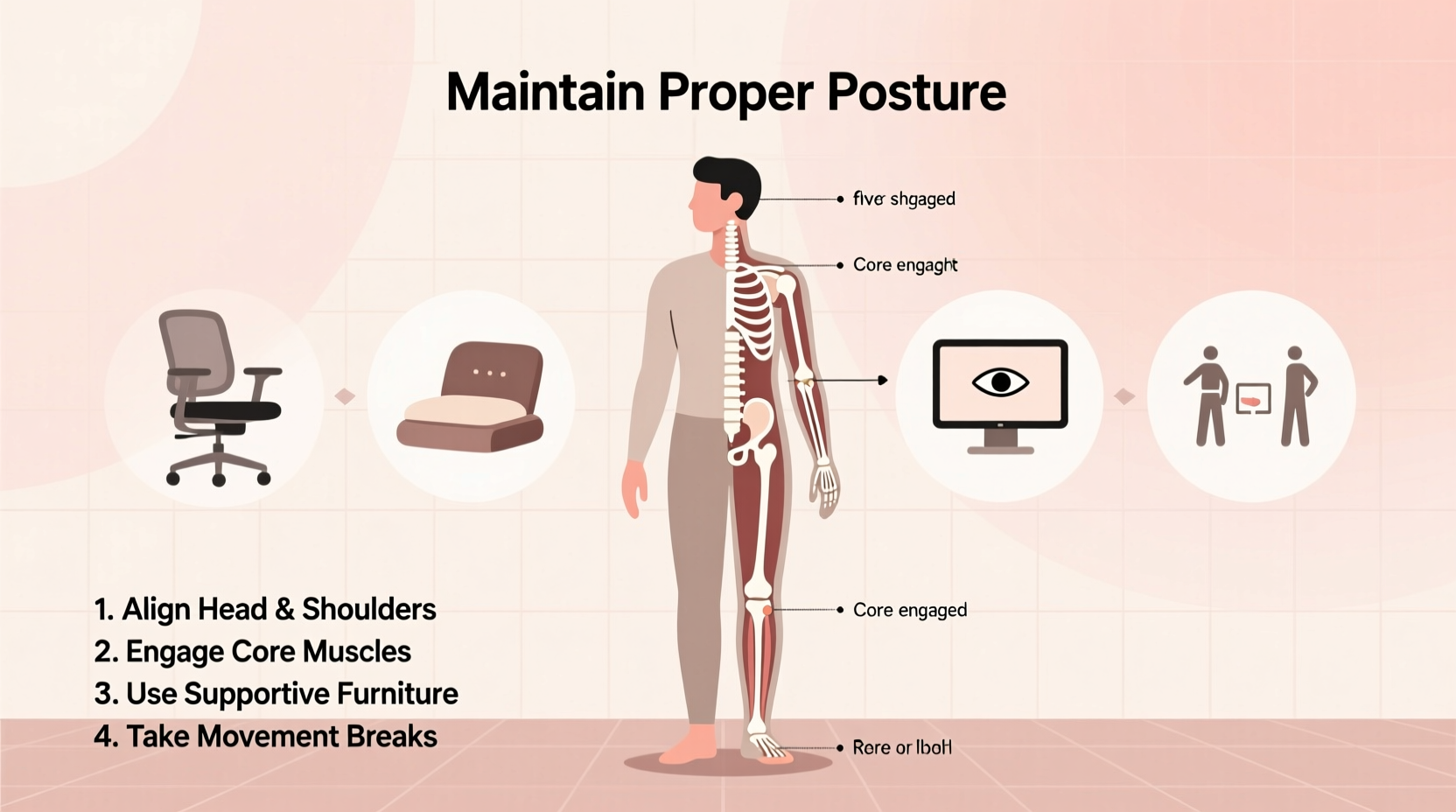In an age dominated by screens and sedentary lifestyles, poor posture has become a silent epidemic. Slouching at desks, craning necks over smartphones, and sitting for hours without movement contribute to chronic back pain, fatigue, and even respiratory inefficiency. Yet, posture is not just about standing up straight—it’s a dynamic alignment that supports spinal health, enhances physical performance, and promotes long-term well-being. The good news: with consistent, mindful adjustments, anyone can improve their posture and enjoy lasting benefits.
The Science Behind Posture and Long-Term Health

Posture refers to the position in which we hold our bodies while standing, sitting, or lying down. Proper alignment ensures that minimal strain is placed on supporting ligaments and muscles during movement or weight-bearing activities. When the spine maintains its natural curves—cervical (neck), thoracic (upper back), and lumbar (lower back)—it distributes mechanical stress efficiently.
Chronic misalignment, such as forward head posture or rounded shoulders, disrupts this balance. Over time, it can lead to muscle imbalances, joint degeneration, nerve compression, and decreased lung capacity. According to the American Chiropractic Association, prolonged poor posture may contribute to conditions like disc herniation, tension headaches, and even digestive issues.
“Your posture reflects your body’s adaptation to daily habits. Correcting it isn’t cosmetic—it’s preventive medicine.” — Dr. Lena Patel, Physical Therapist and Spine Health Specialist
Key Components of Optimal Posture
Good posture isn’t rigid; it’s balanced and adaptable. Whether seated or upright, these structural markers indicate healthy alignment:
- Ears aligned with shoulders: Your earlobe should sit directly above the center of your shoulder when viewed from the side.
- Shoulders relaxed and slightly back: Avoid hunching or winging the shoulder blades.
- Chest open, not collapsed: This allows full diaphragmatic breathing.
- Spine neutral: Maintain gentle inward (lumbar) and outward (thoracic) curves without exaggeration.
- Hips stacked over knees: In sitting, hips should be level or slightly higher than knees.
- Feet flat on the floor: Weight evenly distributed across both feet.
Practical Strategies for Daily Postural Improvement
Improving posture requires more than willpower—it demands environmental design, muscular re-education, and routine reinforcement. Below are evidence-based strategies to integrate into everyday life.
1. Optimize Your Workspace Ergonomics
For many, the desk is where postural damage accumulates. A poorly arranged workstation forces unnatural positions that compound over time.
| Component | Do | Avoid |
|---|---|---|
| Monitor Height | Top third at eye level | Too low (causes neck flexion) |
| Chair Support | Lumbar cushion, adjustable height | No back support or slumped seat |
| Keyboard & Mouse | Elbows at 90°, wrists neutral | Extended reach or raised wrists |
| Sitting Duration | Break every 30–45 minutes | Sitting longer than 60 min uninterrupted |
2. Strengthen Core and Postural Muscles
Weak core and upper back muscles allow the spine to collapse into poor alignment. Targeted exercises build endurance in stabilizing musculature.
Include these movements 3–4 times per week:
- Planks: Hold 20–60 seconds to engage deep abdominal and spinal stabilizers.
- Bird-Dog: Enhances coordination between core and glutes while promoting spinal neutrality.
- Rows with resistance bands: Counteracts rounded shoulders by strengthening rhomboids and lower traps.
- Wall Angels: Stand with back against wall, arms moving slowly up and down like snow angels—improves scapular control.
3. Incorporate Movement Breaks
Sitting is not the enemy—static sitting is. Frequent micro-movements reset muscle tone and reduce stiffness.
- Set a timer to stand or stretch every 30 minutes.
- Perform seated pelvic tilts to activate lumbar awareness.
- Walk for 2–3 minutes every hour—even pacing around your office helps.
- Practice deep breathing while rolling shoulders back.
Mini Case Study: Reversing Tech Neck in an Office Worker
James, a 34-year-old software developer, began experiencing persistent neck pain and frequent headaches after transitioning to remote work. His typical day involved 9+ hours at a dining table with a laptop on a stack of books, eyes six inches from the screen.
After consulting a physical therapist, he implemented three changes:
- Purchased a laptop riser and external keyboard/mouse setup.
- Started daily 10-minute routines including chin tucks and thoracic extensions.
- Used a smartwatch reminder to stand and reset posture hourly.
Within six weeks, James reported a 70% reduction in discomfort and improved energy levels. His follow-up assessment showed measurable improvement in cervical alignment.
Posture Maintenance Checklist
- Adjust chair so feet rest flat and knees are below hips.
- Position monitor at arm’s length and top-third at eye level.
- Take a 2-minute movement break every 45 minutes.
- Perform 5 chin tucks and shoulder blade squeezes hourly.
- End each day with 5 minutes of gentle stretching (cat-cow, child’s pose).
- Use a supportive pillow that keeps neck aligned in sleep.
Frequently Asked Questions
Can poor posture cause permanent damage?
While occasional slouching isn’t harmful, years of neglect can lead to adaptive shortening of muscles, joint remodeling, and disc compression. Early intervention prevents irreversible changes. Research shows that consistent correction—even after years of poor habits—can restore function and reduce pain.
Is sitting cross-legged bad for posture?
Occasional leg crossing isn’t dangerous, but habitual asymmetrical sitting can tilt the pelvis and create imbalances in hip flexors and lower back muscles. It may also contribute to uneven wear in the lumbar discs. Limit cross-legged sitting to brief periods and alternate sides if practiced.
Do posture correctors really work?
Wearable braces may provide temporary feedback but aren’t a long-term solution. Overreliance can weaken postural muscles. They’re most effective when used briefly during training sessions—as a cue—not as all-day crutches. Focus instead on building intrinsic strength and awareness.
Conclusion: Make Posture a Habit, Not a Chore
Maintaining proper posture isn’t about achieving perfection—it’s about cultivating awareness and consistency. Small, repeated actions accumulate into lasting structural health. By redesigning your environment, strengthening key muscle groups, and integrating mindful movement, you protect your spine, boost energy, and enhance overall quality of life.









 浙公网安备
33010002000092号
浙公网安备
33010002000092号 浙B2-20120091-4
浙B2-20120091-4
Comments
No comments yet. Why don't you start the discussion?